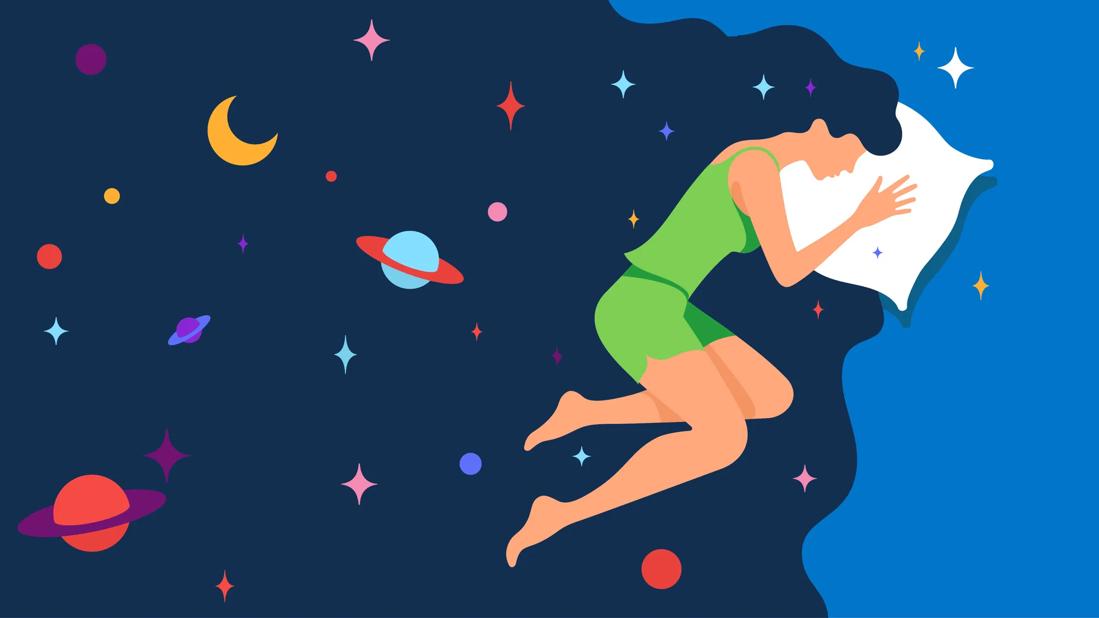Controlling your dreams may help you tap into your creativity and even reduce anxiety

Have you ever experienced a dream where it felt like you were in total control? Maybe you were aware you were dreaming and consciously conjured up new twists and turns, choosing to fly, for example, or changing the scenery with a simple thought. Or maybe you could communicate with other characters you imagined into existence with real-time clarity.
Advertisement
Cleveland Clinic is a non-profit academic medical center. Advertising on our site helps support our mission. We do not endorse non-Cleveland Clinic products or services. Policy
If any of this sounds familiar, you’ve experienced a lucid dream.
Sleep disorder specialist Alicia Roth, PhD, explains what these are and what causes them.
Lucid dreaming is when you consciously realize you’re inside a dream. This type of dreaming is most common during rapid eye movement (REM) sleep, when your brain experiences increased activity during a deep sleep. This heightened state of awareness can sometimes allow you to control the narrative of your dreams so you can experience unparalleled creativity and exploration.
Around 50% of the world’s population experiences lucid dreaming. But there’s much less known about people who claim to have the ability to control or manipulate their dreams.
“Whether it’s lucid dreams, regular dreams or nightmares, dreaming is a very difficult thing to measure objectively,” says Dr. Roth. “There are ways that we can tell when people are in REM sleep. If they’re observed in a sleep study or with an MRI scanner, we can see brain changes. But we can’t even precisely tell when people are actually dreaming.”
Sleep disruptions or disorders that affect REM sleep may increase the frequency of lucid dreams. People with narcolepsy, for example, have lucid dreams more often. Some studies suggest frequent lucid dreaming might even occur because of increased activity between areas of the brain normally deactivated during sleep. These areas are responsible for decision-making and sensory perception.
Advertisement
“REM sleep is when your most vivid dreams occur,” says Dr. Roth, “and it’s a very active time for your brain. If you did a sleep study, your brain during REM sleep looks a lot like it does activity-wise when you’re awake.”
More research is needed to determine the exact causes for lucid dreaming, but available research suggests you’re more likely to have a lucid dream if you’re:
So far, there isn’t enough scientific evidence to say lucid dreaming can be harmful to your health. But interrupting your sleep to induce lucid dreaming can lead to sleep deprivation and issues with:
People with mental health conditions associated with delirium and hallucinations, like psychosis, may also have increased difficulty understanding the difference between lucid dreams and reality.
Still, some research suggests lucid dreaming may help:
In a clinical setting, lucid dreaming is sometimes a result of a technique for helping people with nightmares called imagery rehearsal therapy (IRT). This practice, says Dr. Roth, involves using guided imagery and re-scripting the narrative of nightmares.
“We use pleasant, guided imagery to teach you how to incorporate all five senses, even focusing on creating a scene of something you enjoy doing while you’re awake,” she explains. “Once you start practicing this during the day and before bedtime, it can sometimes work its way into your dreams or prevent you from having a nightmare.”
While you’re awake, a therapist helps you identify the point at which your dreams tend to go wrong and then helps you restructure the narrative.
“When you’re rehearsing these rescripted dreams in your thoughts throughout the day, you’re able to get your brain to organize them in a way that becomes beneficial when you go back to sleep,” Dr. Roth adds.
Our dreams and the way we view the world are so uniquely dependent on who we are as individuals. That’s why we need more research and larger clinical trials to figure out how lucid dreaming could be used more positively.
The more we recognize what we can control and how creative we can be — both in lucid dreams and reality — the easier we can rest. And we could all use better sleep these days.
Advertisement
Learn more about our editorial process.
Advertisement

Stick to a consistent schedule, be mindful of screen time and work on reducing your stress levels before bed

Napping can boost focus, memory and mood — if you time it right
These devices can help shed light on what’s happening with your body during rest

Keep a dream journal, set your intentions before bed and make sure you’re getting a full night of high-quality sleep

A 15- to 20-minute power nap is best to boost alertness — beware napping longer than an hour

Limited research suggests a weighted blanket may help with anxiety, insomnia and other conditions

If you’re putting off going to bed to have some time for yourself, you’re not doing your well-being any favors
Try setting a regular sleep schedule, creating a comfortable sleep environment and reducing stress

Start having sex about 72 hours before ovulation, then at least every other day during your fertile window

Attachment theory suggests that your earliest relationships shape connections throughout your life

It isn’t a recognized mental health disorder, but research shows that problematic social media use can negatively affect your mental health, self-esteem and sleep